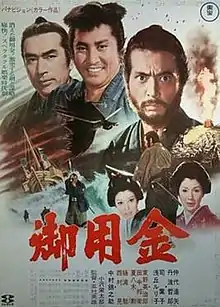Goyokin
Goyokin (御用金, Goyōkin, "Official Gold") is a 1969 jidaigeki film directed by Hideo Gosha. Set during the late Tokugawa period, the story follows a reclusive rōnin who is trying to atone for past transgressions.[2][3]
| Goyokin | |
|---|---|
 Japanese film poster | |
| Directed by | Hideo Gosha |
| Produced by |
|
| Screenplay by |
|
| Starring | |
| Music by | Masaru Sato[1] |
| Cinematography | Kozo Okazaki[1] |
Production companies |
|
| Distributed by | Toho |
Release date |
|
Running time | 124 minutes[1] |
| Country | Japan |
Plot
Magobei Wakizaka is a samurai for the Sabai clan. A nearby island, Sado, boasts a rich gold mine which provides plentiful riches[4] for the Tokugawa clan. When one of the gold ships sink, the local fishermen recover some of the gold, intending to return it to the Tokugawa clan. However, Magobei's clan master, Rokugo Tatewaki, takes the gold and slaughters the fishermen so they cannot report the gold stolen. Magobei is appalled. He promises not to report Rokugo to the shogunate in exchange for Rokugo's promise to never do so again.
However, three years later, assassins sent by Rokugo's retainer, Kunai, come for Magobei, who is living in Edo. He realizes that Rokugo intends to steal more gold and slaughter more innocents. So Magobei returns to Sabai to face his former master. Rokugo hires another ronin, Samon Fujimaki, to kill Magobei, but Magobei eventually wins him over. Also, along the way, Magobei meets a young woman, Oriha, who survived the original slaughter. She and her brother, Rokuzo, join him on his way to Sabai.
At Sabai they learn that Rokugo intends to move a bonfire, which serves as a warning to passing ships against dangerous rocks, so that a gold ship will hit the rocks and sink. After recovering the gold, Rokugo intends to slaughter the peasants who help him in this endeavor. The combined efforts of Magobei, Samon, Oriha, and Rokuzo result in the correct bonfire being lit, the fake bonfire being put out, and the innocent peasants' lives being saved. Thus the gold-bearing ship evades the rocks. In a final showdown, amid falling snow, Magobei slays Rokugo, but is wounded by one of Rokugo's throwing knives.
Cast
- Tatsuya Nakadai as Magobei Wakizaka
- Kinnosuke Nakamura as Samon Fujimaki
- Tetsurō Tamba as Rokugo Tatewaki, Magobei's childhood friend, brother-in-law, and clan master
- Yoko Tsukasa as Shino, Rokugo's sister and Magobei's wife
- Ruriko Asaoka as Oriha
- Isao Natsuyagi as Kunai
- Ben Hiura as Rokuzo
- Kunie Tanaka as Hirosuke
- Susumu Kurobe as Omura Sobei
- Kō Nishimura as Ryu Ichigaku
- Hisashi Igawa as Takeuchi
- Eijirō Tōno as a Chief retainer
Production
Goyokin was the first Japanese production shot in Panavision.[1] Initially, Toshiro Mifune was cast Kinnosuke Nakamura's role, but was replaced several weeks into filming.[1]
Release
Goyokin was released as a roadshow theatrical release in Japan on 1 May 1969 where it was distributed by Toho.[1] The film received a general release in Japan on 17 May 1969.[1]
The film was released in the United States by Toho International with English subtitles in September 1969.[1] It was reissued in the United States with an English-language dub and a running time of 85 minutes under the title The Steel Edge of Revenge in September 1974.[1]
Reception
Goyokin won the awards for Best Cinematography and Best Art Direction (Motoji Kojima) at the Mainichi Film Concours.[1]
References
Footnotes
- Galbraith IV 2008, p. 257.
- "御用金". Agency for Cultural Affairs. Retrieved January 2, 2020.
- "御用金". Kinema Junpo. Retrieved 27 December 2020.
- This gold was called goyokin, roughly translated as "gold for official use", hence the title of the film.
Sources
- Galbraith IV, Stuart (2008). The Toho Studios Story: A History and Complete Filmography. Scarecrow Press. ISBN 1461673747.CS1 maint: ref=harv (link)
External links
- Goyōkin at IMDb
- Goyokin at AllMovie
- Review at Kung Fu Cinema
- Review at SaruDama
- (in Japanese) Goyokin at the Japanese Movie Database